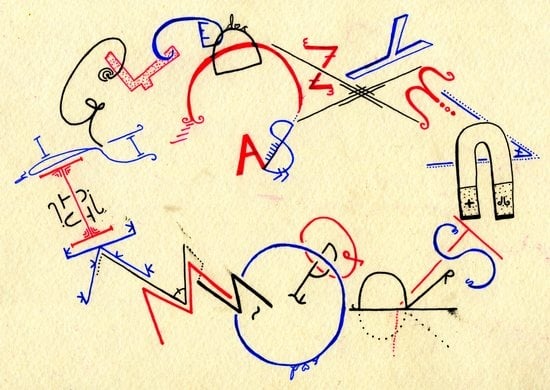Partner Pen Play in Parallel (PPPiP): A New PPPiParadigm for Relationship Improvement
Abstract
1. Introduction
2. PPPiP—What and Why?
2.1. What Is PPPiP?
2.2. Why Do PPPiP?
2.2.1. Evidence from Traditional Art Therapy
2.2.2. Attention and Neural Synchrony
2.2.3. Partner Improvisation
2.2.4. Controlled Novelty
2.2.5. Art on the Brain
2.2.6. Free Energy and PPPiP (FEPPPPiP)
3. Differences between PPPiP and Traditional Art Therapy
4. Future Directions
5. Conclusions
Author Contributions
Funding
Acknowledgments
Conflicts of Interest
Appendix A. Examples of “Fontplay” PPPiP’s

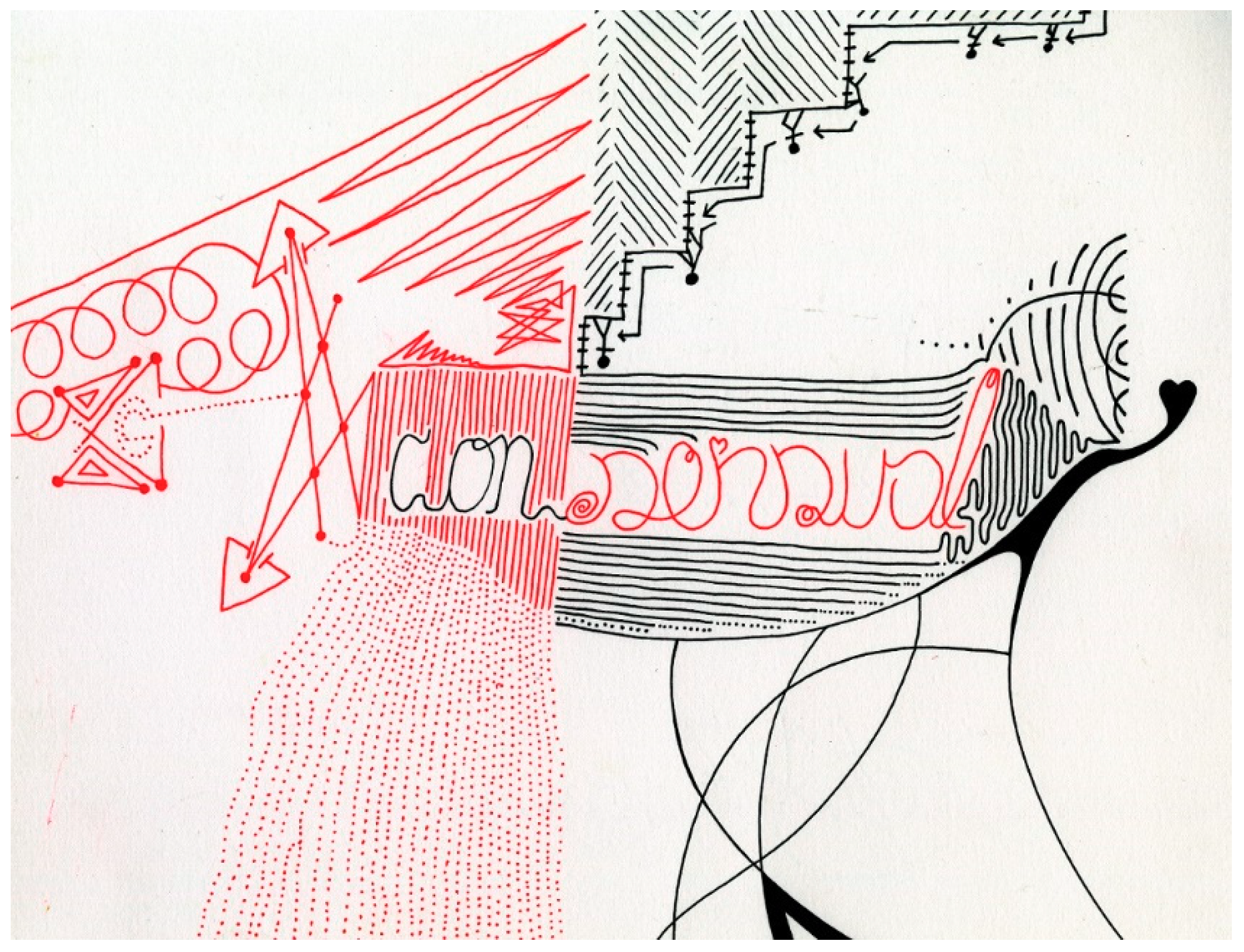
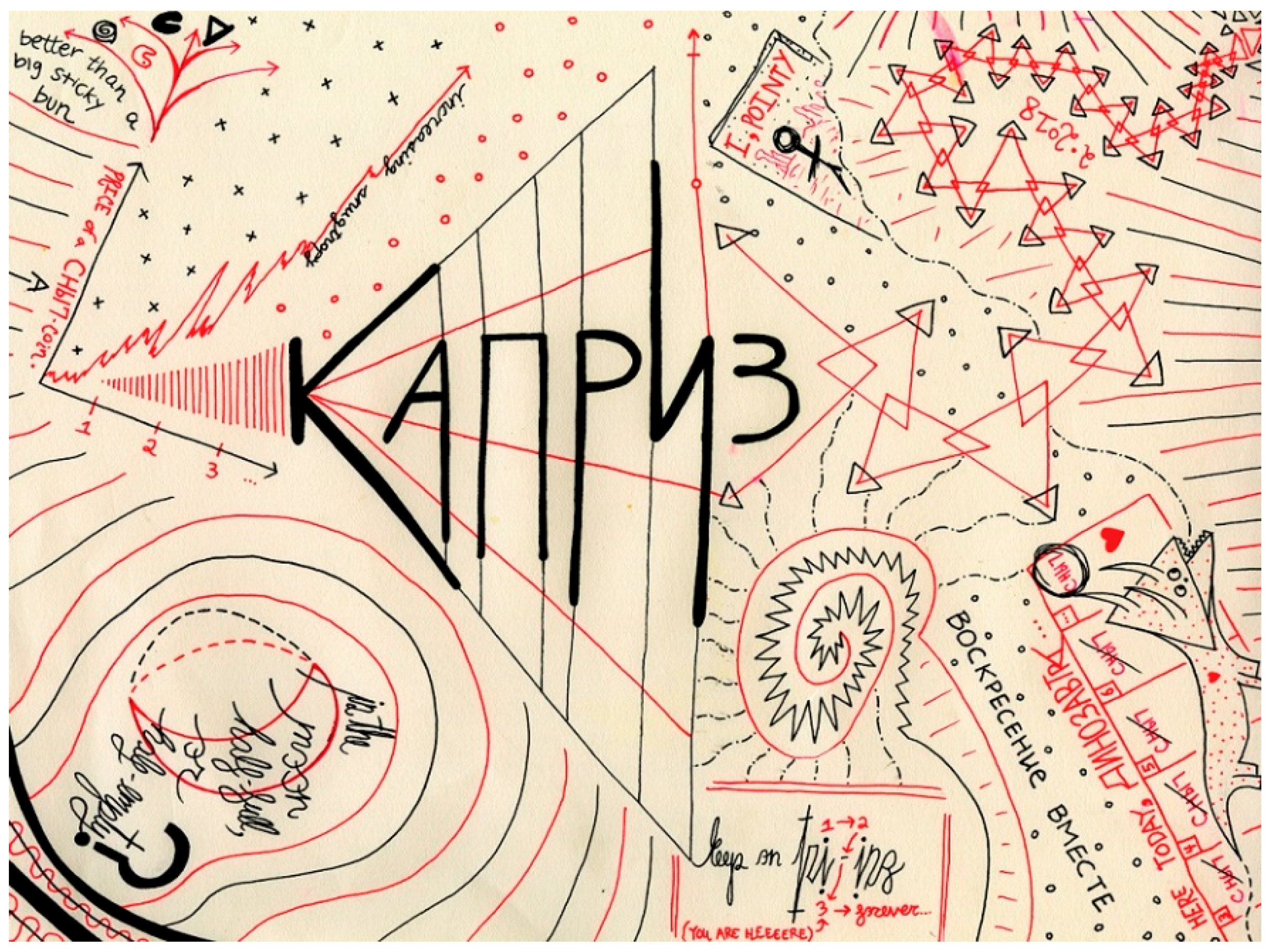
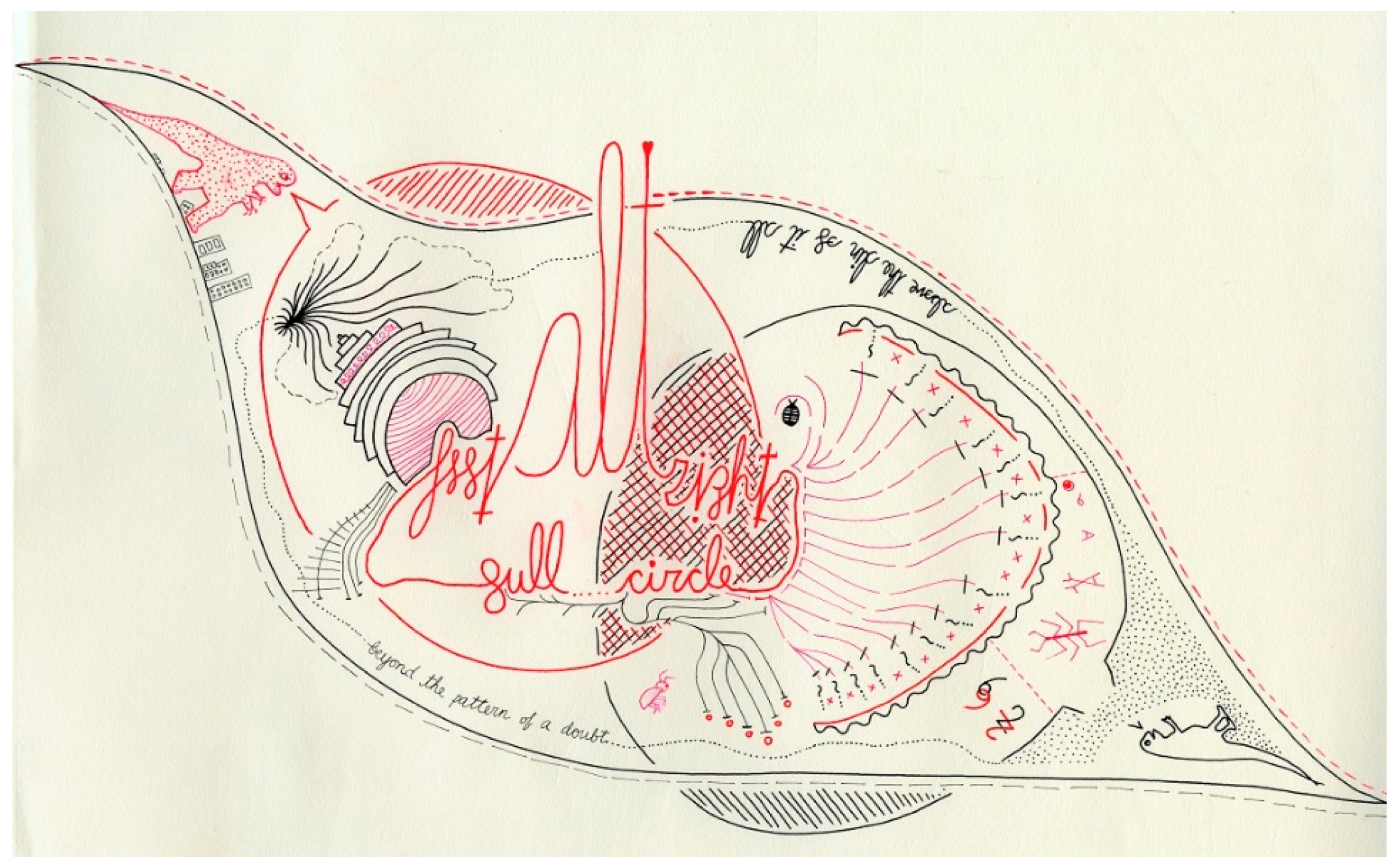
Appendix B. Examples of “Pure Abstraction” PPPiP’s
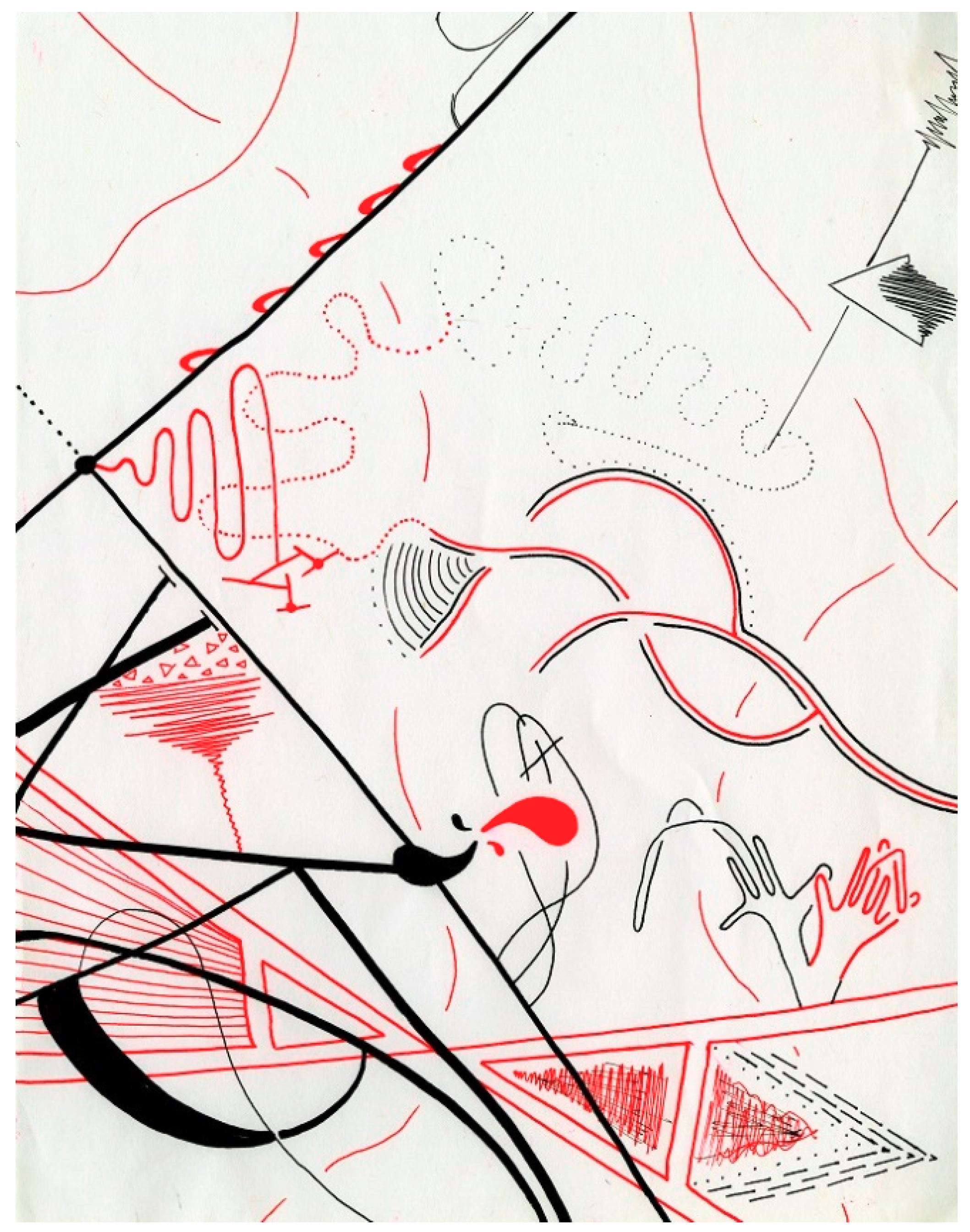
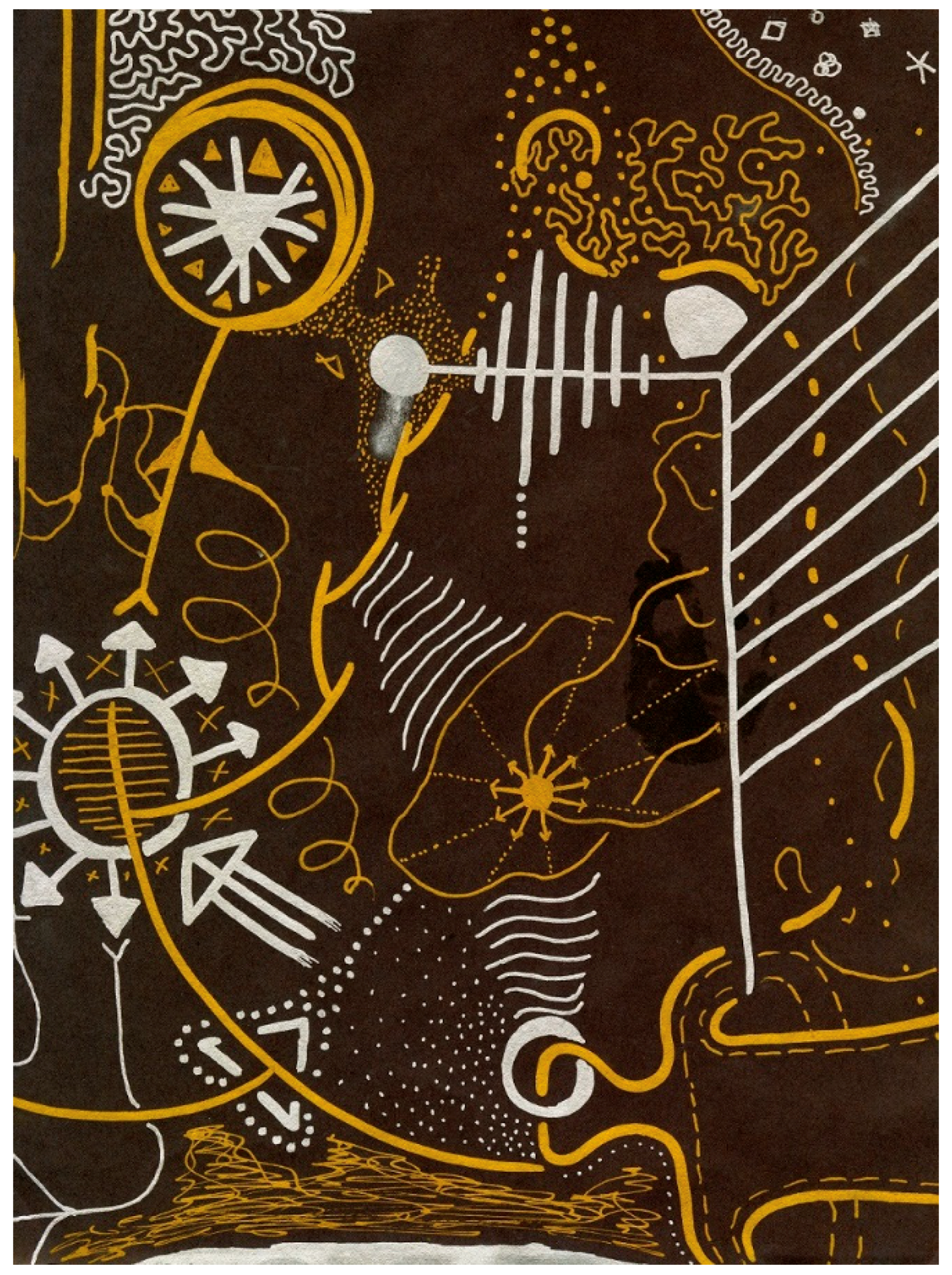
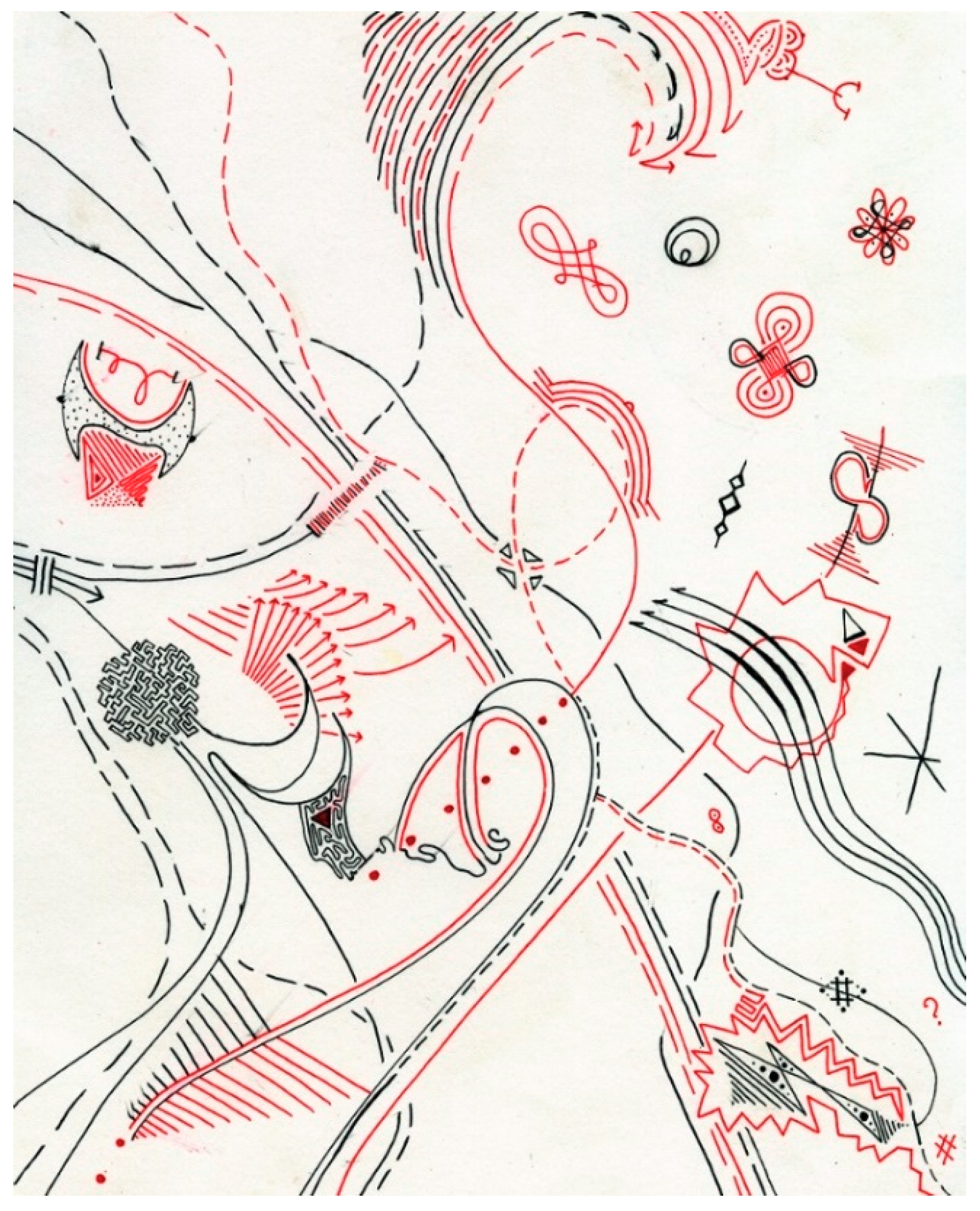
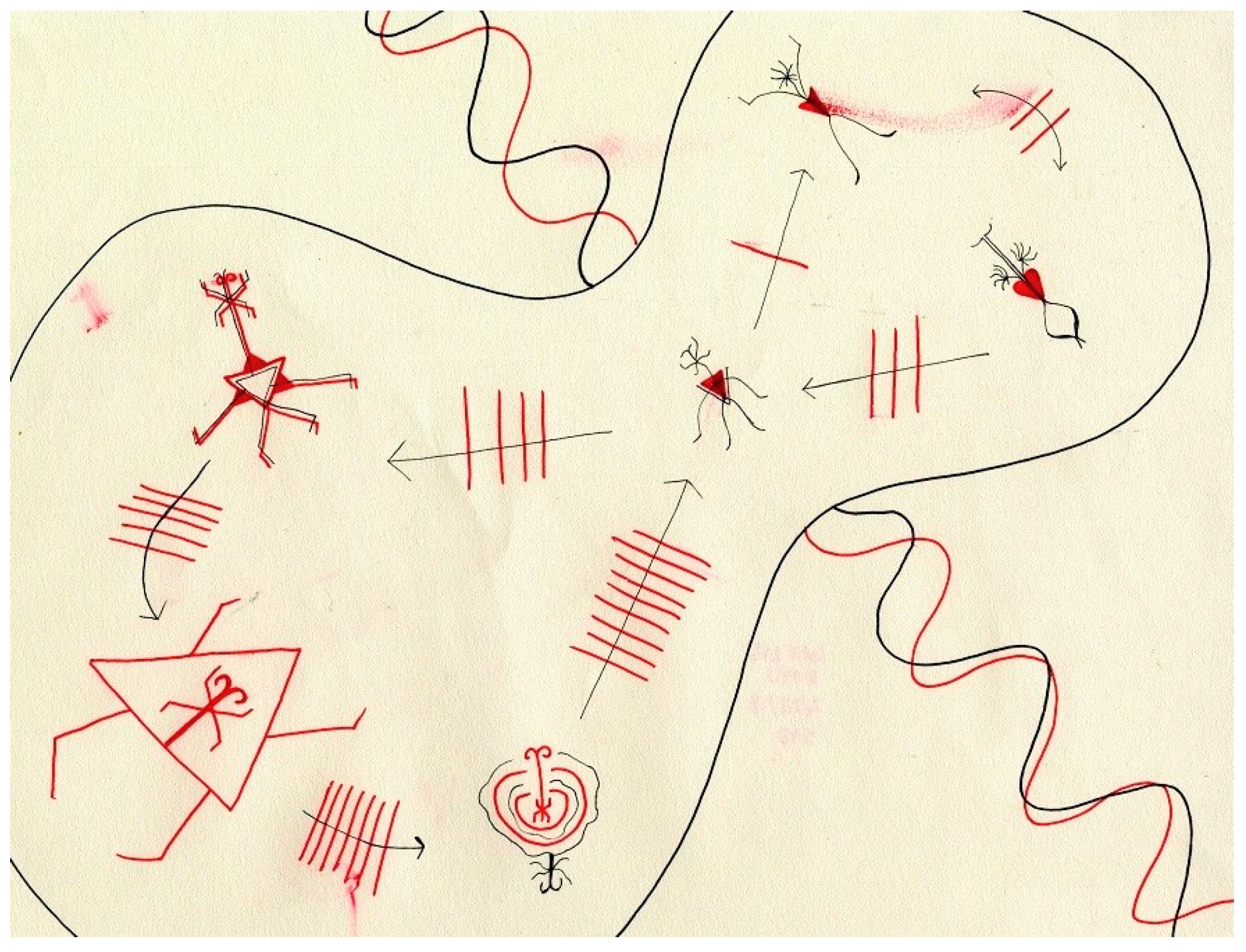
References
- Aviv, Vered. 2014. What Does the Brain Tell Us about Abstract Art? Frontiers in Human Neuroscience 8: 85. [Google Scholar] [CrossRef] [PubMed]
- Badcock, Paul B., Christopher G. Davey, Sarah Whittle, Nicholas B. Allen, and Karl J. Friston. 2017. The Depressed Brain: An Evolutionary Systems Theory. Trends in Cognitive Sciences 21: 182–94. [Google Scholar] [CrossRef] [PubMed]
- Bazzi, Angela Robertson, Kirkpatrick B. Fergus, Rob Stephenson, Catherine A. Finneran, Julia Coffey-Esquivel, Marco A. Hidalgo, Sam Hoehnle, Patrick S. Sullivan, Robert Garofalo, and Matthew J. Mimiaga. 2016. A Dyadic Behavioral Intervention to Optimize Same Sex Male Couples’ Engagement Across the HIV Care Continuum: Development of and Protocol for an Innovative Couples-Based Approach (Partner Steps). JMIR Research Protocols 5: e168. [Google Scholar] [CrossRef] [PubMed]
- Blocker, Tomica D., and Alexander G. Ophir. 2016. A Preference to Bond? Male Prairie Voles Form Pair Bonds Even in the Presence of Multiple Receptive Females. Animal Behaviour 122: 89–97. [Google Scholar] [CrossRef] [PubMed]
- Bradbury, Thomas N., and Justin A. Lavner. 2012. How Can We Improve Preventive and Educational Interventions for Intimate Relationships? Behavior Therapy 43: 113–22. [Google Scholar] [CrossRef] [PubMed]
- Brown, Steven, Xiaoqing Gao, Loren Tisdelle, Simon B. Eickhoff, and Mario Liotti. 2011. Naturalizing Aesthetics: Brain Areas for Aesthetic Appraisal across Sensory Modalities. NeuroImage 58: 250–58. [Google Scholar] [CrossRef] [PubMed]
- Cacioppo, Stephanie, Chris Frum, Erik Asp, Robin M. Weiss, James W. Lewis, and John T. Cacioppo. 2013. A Quantitative Meta-Analysis of Functional Imaging Studies of Social Rejection. Scientific Reports 3: 2027. [Google Scholar] [CrossRef] [PubMed]
- Chauvigné, Léa A. S., Michel Belyk, and Steven Brown. 2018. Taking Two to Tango: fMRI Analysis of Improvised Joint Action with Physical Contact. PLoS ONE 13: e0191098. [Google Scholar] [CrossRef] [PubMed]
- Constant, Axel, Maxwell J. D. Ramstead, Samuel P. L. Veissière, John O. Campbell, and Karl J. Friston. 2018. A Variational Approach to Niche Construction. Journal of the Royal Society, Interface/The Royal Society 15: 20170685. [Google Scholar] [CrossRef] [PubMed]
- Debrot, Anik, Nathalie Meuwly, Amy Muise, Emily A. Impett, and Dominik Schoebi. 2017. More Than Just Sex: Affection Mediates the Association Between Sexual Activity and Well-Being. Personality & Social Psychology Bulletin 43: 287–99. [Google Scholar] [CrossRef]
- Dikker, Suzanne, Lu Wan, Ido Davidesco, Lisa Kaggen, Matthias Oostrik, James McClintock, Jess Rowland, Georgios Michalareas, Jay J. Van Bavel, Mingzhou Ding, and et al. 2017. Brain-to-Brain Synchrony Tracks Real-World Dynamic Group Interactions in the Classroom. Current Biology 27: 1375–80. [Google Scholar] [CrossRef] [PubMed]
- Friston, Karl. 2017. Consciousness Is Not a Thing, but a Process of Inference—Karl Friston|Aeon Essays. Aeon. Aeon. Available online: https://aeon.co/essays/consciousness-is-not-a-thing-but-a-process-of-inference (accessed on 18 May 2017).
- Froese, Tom. 2015. Enactive Neuroscience, the Direct Perception Hypothesis, and the Socially Extended Mind. The Behavioral and Brain Sciences 38: e75. [Google Scholar] [CrossRef] [PubMed]
- Garcia, Justin R., Chris Reiber, Sean G. Massey, and Ann M. Merriwether. 2012. Sexual Hookup Culture: A Review. Review of General Psychology 16: 161–76. [Google Scholar] [CrossRef] [PubMed]
- Halford, W. Kim, Christopher A. Pepping, and Jemima Petch. 2016. The Gap Between Couple Therapy Research Efficacy and Practice Effectiveness. Journal of Marital and Family Therapy 42: 32–44. [Google Scholar] [CrossRef] [PubMed]
- Herrera-Arcos, Guillermo, Jesús Tamez-Duque, Elsa Y. Acosta-De-Anda, Kevin Kwan-Loo, Mayra de-Alba, Ulises Tamez-Duque, Jose L. Contreras-Vidal, and Rogelio Soto. 2017. Modulation of Neural Activity during Guided Viewing of Visual Art. Frontiers in Human Neuroscience 11: 581. [Google Scholar] [CrossRef] [PubMed]
- Hu, Yi, Yinying Hu, Xianchun Li, Yafeng Pan, and Xiaojun Cheng. 2017. Brain-to-Brain Synchronization across Two Persons Predicts Mutual Prosociality. Social Cognitive and Affective Neuroscience 12: 1835–44. [Google Scholar] [CrossRef] [PubMed]
- Issartel, Johann, Mathieu Gueugnon, and Ludovic Marin. 2017. Understanding the Impact of Expertise in Joint and Solo-Improvisation. Frontiers in Psychology 8: 1078. [Google Scholar] [CrossRef] [PubMed]
- Jardine, Boris. 2017. State of the Field: Paper Tools. Studies in History and Philosophy of Science 64: 53–63. [Google Scholar] [CrossRef] [PubMed]
- Jhai, Zong-Ti. 2017. Impact of a Romantic Relationships Counseling Group Project on Deaf Male Adolescents in a Deaf School. Sexuality and Disability 35: 185–206. [Google Scholar] [CrossRef]
- Kawabata, Hideaki, and Semir Zeki. 2004. Neural Correlates of Beauty. Journal of Neurophysiology 91: 1699–705. [Google Scholar] [CrossRef] [PubMed]
- Keskin, Burhanettin. 2009. How Would Theory of Mind Play a Role in Comprehending Art? Early Child Development and Care 179: 645–49. [Google Scholar] [CrossRef]
- Kinreich, Sivan, Amir Djalovski, Lior Kraus, Yoram Louzoun, and Ruth Feldman. 2017. Brain-to-Brain Synchrony during Naturalistic Social Interactions. Scientific Reports 7: 17060. [Google Scholar] [CrossRef] [PubMed]
- Linksvayer, Timothy A. 2015. Chapter Eight—The Molecular and Evolutionary Genetic Implications of Being Truly Social for the Social Insects. In Advances in Insect Physiology. Edited by Amro Zayed and Clement F. Kent. Cambridge: Academic Press, vol. 48, pp. 271–92. [Google Scholar]
- Liu, Ning, Charis Mok, Emily E. Witt, Anjali H. Pradhan, Jingyuan E. Chen, and Allan L. Reiss. 2016. NIRS-Based Hyperscanning Reveals Inter-Brain Neural Synchronization during Cooperative Jenga Game with Face-to-Face Communication. Frontiers in Human Neuroscience 10: 82. [Google Scholar] [CrossRef] [PubMed]
- Livingston, Judith A. 1999. Something Old and Something New: Love, Creativity, and the Enduring Relationship. Bulletin of the Menninger Clinic 63: 40–52. [Google Scholar] [PubMed]
- McDaniel, Brandon T., Adam M. Galovan, Jaclyn D. Cravens, and Michelle Drouin. 2018. Technoference and Implications for Mothers’ and Fathers’ Couple and Coparenting Relationship Quality. Computers in Human Behavior 80: 303–13. [Google Scholar] [CrossRef]
- Metzl, Einat S. 2016. When Art Therapy Meets Sex Therapy: Creative Explorations of Sex, Gender, and Relationships. Abingdon: Taylor & Francis. [Google Scholar]
- Monson, Candice M., Casey T. Taft, and Steffany J. Fredman. 2009. Military-Related PTSD and Intimate Relationships: From Description to Theory-Driven Research and Intervention Development. Clinical Psychology Review 29: 707–14. [Google Scholar] [CrossRef] [PubMed]
- Moreau, Quentin, Lucie Galvan, Tatjana A. Nazir, and Yves Paulignan. 2016. Dynamics of Social Interaction: Kinematic Analysis of a Joint Action. Frontiers in Psychology 7: 2016. [Google Scholar] [CrossRef] [PubMed]
- Morville, Tobias, Karl Friston, Denis Burdakov, Hartwig R. Siebner, and Oliver J. Hulme. 2018. The Homeostatic Logic of Reward. bioRxiv. [Google Scholar] [CrossRef]
- Nadal, Marcos, and Martin Skov. 2018. The Pleasure of Art as a Matter of Fact. Proceedings of the Royal Society B 285: 20172252. [Google Scholar] [CrossRef] [PubMed]
- Noy, Lior, Erez Dekel, and Uri Alon. 2011. The Mirror Game as a Paradigm for Studying the Dynamics of Two People Improvising Motion Together. Proceedings of the National Academy of Sciences of the United States of America 108: 20947–52. [Google Scholar] [CrossRef] [PubMed]
- Noy, Lior, Nava Levit-Binun, and Yulia Golland. 2015. Being in the Zone: Physiological Markers of Togetherness in Joint Improvisation. Frontiers in Human Neuroscience 9: 187. [Google Scholar] [CrossRef] [PubMed]
- Oppenheimer, Mark. 2011. Dan Savage on the Virtues of Infidelity. The New York Times. June 30. Available online: https://www.nytimes.com/2011/07/03/magazine/infidelity-will-keep-us-together.html (accessed on 29 May 2018).
- Paxton, Alexandra, and Rick Dale. 2017. Interpersonal Movement Synchrony Responds to High- and Low-Level Conversational Constraints. Frontiers in Psychology 8: 1135. [Google Scholar] [CrossRef] [PubMed]
- Pelowski, Matthew, Patrick S. Markey, Michael Forster, Gernot Gerger, and Helmut Leder. 2017. Move Me, Astonish Me… Delight My Eyes and Brain: The Vienna Integrated Model of Top-down and Bottom-up Processes in Art Perception (VIMAP) and Corresponding Affective, Evaluative, and Neurophysiological Correlates. Physics of Life Reviews 21: 80–125. [Google Scholar] [CrossRef] [PubMed]
- Peterson, Jordan B. 1999. Maps of Meaning: The Architecture of Belief. Abingdon: Routledge. [Google Scholar]
- Peterson, Jordan B. 2011. Creative Exploration and Its Illnesses. Canadian Journal of Psychiatry. Revue Canadienne de Psychiatrie 56: 129–31. [Google Scholar] [CrossRef] [PubMed]
- Pietromonaco, Paula R., and Nancy L. Collins. 2017. Interpersonal Mechanisms Linking Close Relationships to Health. The American Psychologist 72: 531–42. [Google Scholar] [CrossRef] [PubMed]
- Ramstead, Maxwell James Désormeau, Paul Benjamin Badcock, and Karl John Friston. 2018. Answering Schrödinger’s Question: A Free-Energy Formulation. Physics of Life Reviews 24: 1–16. [Google Scholar] [CrossRef] [PubMed]
- Resac, Alison. 2018. Millenials as a Loveless Generation. Available online: https://opus.ipfw.edu/stu_symp2018/53/ (accessed on 29 May 2018).
- Robinson, Stefan, Adam White, and Eric Anderson. 2017. Privileging the Bromance: A Critical Appraisal of Romantic and Bromantic Relationships. Men and Masculinities. [Google Scholar] [CrossRef]
- Baxter, Leslie A., and Erin M. Sahlstein. 2001. Improvising Commitment in Close Relationships: A Relational Dialectics Perspective. In Close Romantic Relationships. London: Psychology Press. Available online: https://books.google.com/books?hl=en&lr=&id=8it5AgAAQBAJ&oi=fnd&pg=PA115&dq=improvisation+relationship+intimacy&ots=PqncBx2CfL&sig=tyPzgJ74fK5HeDmYEfBpQ6jMwQo (accessed on 29 May 2018).
- Sapolsky, Robert M. 2017. Behave: The Biology of Humans at Our Best and Worst. London: Penguin Press. Available online: https://www.amazon.com/Behave-Biology-Humans-Best-Worst/dp/1594205078 (accessed on 29 May 2018).
- Schilbach, Leonhard, Bert Timmermans, Vasudevi Reddy, Alan Costall, Gary Bente, Tobias Schlicht, and Kai Vogeley. 2013. Toward a Second-Person Neuroscience 1. The Behavioral and Brain Sciences 36: 393–414. [Google Scholar] [CrossRef] [PubMed]
- Schoenfeld, Elizabeth A., Timothy J. Loving, Mark T. Pope, Ted L. Huston, and Aleksandar Štulhofer. 2017. Does Sex Really Matter? Examining the Connections Between Spouses’ Nonsexual Behaviors, Sexual Frequency, Sexual Satisfaction, and Marital Satisfaction. Archives of Sexual Behavior 46: 489–501. [Google Scholar] [CrossRef] [PubMed]
- Seth, Anil K., and Karl J. Friston. 2016. Active Interoceptive Inference and the Emotional Brain. Philosophical Transactions of the Royal Society of London. Series B, Biological Sciences 371: 20160007. [Google Scholar] [CrossRef] [PubMed]
- Slayton, Sarah C., Jeanne D’Archer, and Frances Kaplan. 2010. Outcome Studies on the Efficacy of Art Therapy: A Review of Findings. Art Therapy 27: 108–18. [Google Scholar] [CrossRef]
- Smith, Glenn W. 2018. Re: Sex-Bots—Let Us Look before We Leap. Arts 7: 15. [Google Scholar] [CrossRef]
- Snir, Sharon, and Hadas Wiseman. 2010. Attachment in Romantic Couples and Perceptions of a Joint Drawing Session. The Family Journal 18: 116–26. [Google Scholar] [CrossRef]
- Song, Beibei. 2018. Art, Science, and Technology of Human Sexuality. Arts 7: 6. [Google Scholar] [CrossRef]
- Sussman, Bethany L., Samir Reddigari, and Sharlene D. Newman. 2018. The Impact of Inverted Text on Visual Word Processing: An fMRI Study. Brain and Cognition 123: 1–9. [Google Scholar] [CrossRef] [PubMed]
- Tschacher, Wolfgang, Anne Giersch, and Karl Friston. 2017. Embodiment and Schizophrenia: A Review of Implications and Applications. Schizophrenia Bulletin 43: 745–53. [Google Scholar] [CrossRef] [PubMed]
- Wadeson, Harriet. 2010. Art Psychotherapy. New York: John Wiley & Sons. [Google Scholar]
- Wells, Taylor M., and Alan R. Dennis. 2016. To Email or Not to Email: The Impact of Media on Psychophysiological Responses and Emotional Content in Utilitarian and Romantic Communication. Computers in Human Behavior 54: 1–9. [Google Scholar] [CrossRef]
- Zerubavel, Noam, Mark Anthony Hoffman, Adam Reich, Kevin N. Ochsner, and Peter Bearman. 2018. Neural Precursors of Future Liking and Affective Reciprocity. Proceedings of the National Academy of Sciences of the United States of America 115: 4375–80. [Google Scholar] [CrossRef] [PubMed]
© 2018 by the authors. Licensee MDPI, Basel, Switzerland. This article is an open access article distributed under the terms and conditions of the Creative Commons Attribution (CC BY) license (http://creativecommons.org/licenses/by/4.0/).
Share and Cite
Mikhailova, A.; Friedman, D.A. Partner Pen Play in Parallel (PPPiP): A New PPPiParadigm for Relationship Improvement. Arts 2018, 7, 39. https://doi.org/10.3390/arts7030039
Mikhailova A, Friedman DA. Partner Pen Play in Parallel (PPPiP): A New PPPiParadigm for Relationship Improvement. Arts. 2018; 7(3):39. https://doi.org/10.3390/arts7030039
Chicago/Turabian StyleMikhailova, Alexandra, and Daniel A. Friedman. 2018. "Partner Pen Play in Parallel (PPPiP): A New PPPiParadigm for Relationship Improvement" Arts 7, no. 3: 39. https://doi.org/10.3390/arts7030039
APA StyleMikhailova, A., & Friedman, D. A. (2018). Partner Pen Play in Parallel (PPPiP): A New PPPiParadigm for Relationship Improvement. Arts, 7(3), 39. https://doi.org/10.3390/arts7030039




